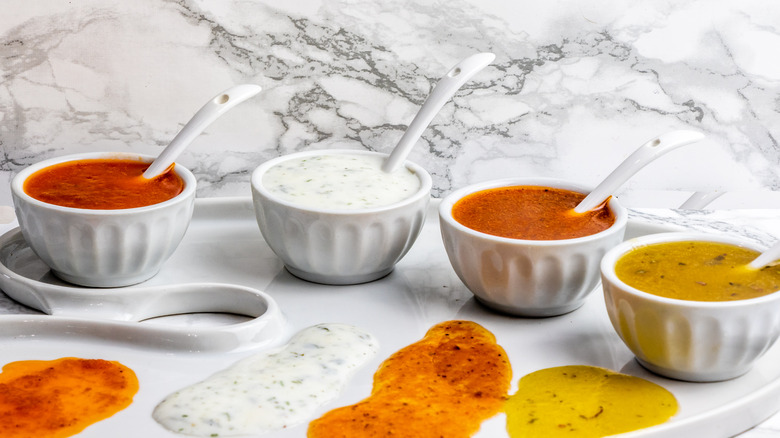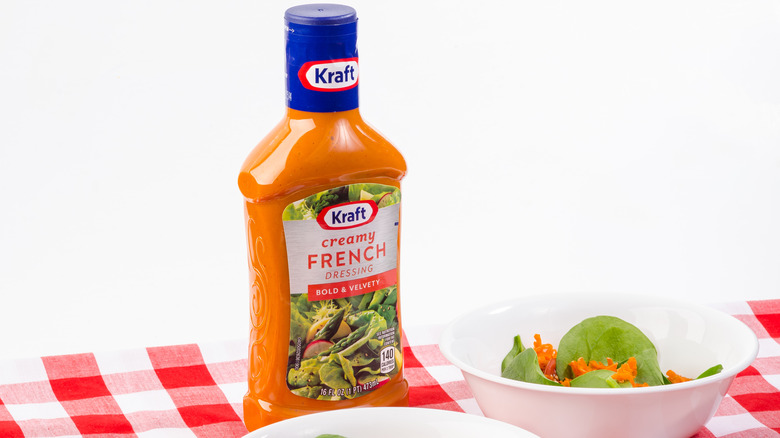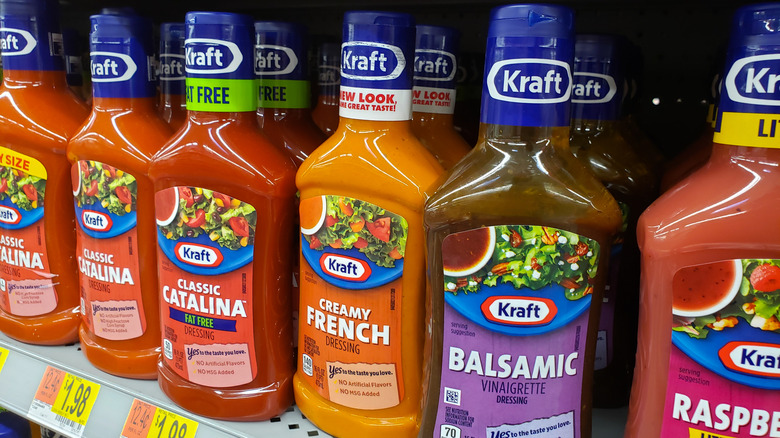What's The Difference Between Catalina And French Dressing?
Next time you're at the grocery store, head to the salad dressing section and take note of how many different styles of dressing there are on offer (it's probably a lot). Some are wildly popular, like Ranch, and some, like balsamic vinaigrette, are pretty self-explanatory. But you could be forgiven for not being able to pick some of them out of a lineup. Catalina and French dressing, both orange in color, are particularly hard to differentiate.
The two are similar, but not exactly the same. Catalina is often considered a subset of French dressing, with most of the same ingredients — ketchup, oil, vinegar, sugar, and other seasonings — but in different proportions. French dressing tends to contain more oil and spices, while Catalina has a higher proportion of ketchup. As a result, French dressing is usually lighter in color and a bit creamier than Catalina.
As you might suspect based on the inclusion of ketchup, "French" dressing as we know it is a distinctly American invention, probably owing more to Kraft Foods than to any European culinary tradition. But the century-old concoction is still popular enough that you can find it at basically any grocery store or salad bar in the U.S.
As French as french fries
In the late 1800s, "French dressing" was what the English-speaking world called the kind of dressing we now know as vinaigrette — a simple mixture of emulsified oil and vinegar, plus other flavoring ingredients. French dressing (the orange kind) does contain both oil and vinegar, but it was around the 1920s that the version made with paprika and often ketchup or another form of tomato gained popularity (hence, the orange color). With the advent of packaged foods happening around the same time, bottled French dressing started hitting the shelves and cemented its identity as a creamy orange mixture (at least, in the U.S.; in the U.K., "French dressing" still usually refers to a basic vinaigrette).
The basic distinction between the two is that Catalina contains more ketchup, less oil, and usually fewer spices than French dressing, making for a deeper red-orange color. Because French dressing has more oil, it tends to taste creamier and look a paler shade of orange. But truth be told, when it comes to homemade dressing, the many recipes out there for Catalina and French dressing are virtually indistinguishable, with plenty of Catalinas containing a rich blend of spices themselves.
Should you make French dressing or buy it?
If you want to skip the homemade stuff and do things the American way — that is, by buying pre-made bottled dressing — there are plenty of options on the market, including fat-free and differently seasoned variations. It's worth noting that while most recipes for Catalina and French dressings are dairy-free, Kraft's French contains skim milk powder (heads up, vegans), though Catalina doesn't. But other major salad dressing brands, like Wishbone, don't include any dairy in their take on French dressing. As with anything, if you have any dietary restrictions, be sure to check the label when picking a dressing to make sure there aren't any ingredients you can't have.
French and Catalina are both zesty, a little tart, and sweet, and either one will introduce a bold orange color to your salad plate (albeit two slightly different shades). If you're a ketchup lover, one or both is likely to be your new favorite — if it wasn't already.


